#AI-100 Sample Questions
Explore tagged Tumblr posts
Text

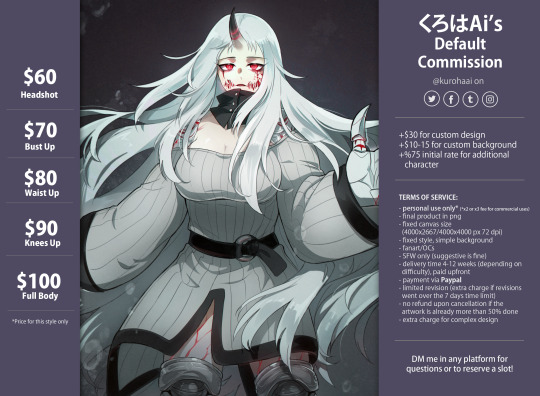







Hello, Ai here 🌸 (that’s my artist name; yes I draw things with my hands). This month I want to branch out with the default and scribble styles!
✨OPENING 5 SLOTS✨
Starts from $45~100* (additional fees & type of comms on my TOS)
Personal use only! (commercial use is available with 2x to 3x rate depending on the license you choose)
Fanart/OC/self-ship OK! As long as it’s from the styles offered above
Custom design OK! (additional fees on my TOS)
Payment via Paypal
TAT 4-12 weeks
PM me to reserve a slot or if you have questions in general ^^ Or fill in the Kuroha Ai’s Commission Form!
Reblogs would be deeply appreciated! Feel free to browse my blog or see my carrd for more samples, thank you again 🌸
#kuroha ai#commission#anime art#fanart#oc#yumeship#dnd#here you can see this artist trying to do her best at artisting#heart full of love brain full of nothing
74 notes
·
View notes
Text
I blogged before about this company, Orange, that is an AI-powered manga translation company. Essentially, their pitch is that most manga is still (officially) untranslated, a ton of manga gets made after all but few become mainstream enough to get ported overseas. They posit the barrier to that is the cost of translation; if they could automate that process, then they can make viable for release what previously was not. That concept rests on two questions - does the tech pan out, and does the economics add up?
Recently they went live, under the name Emaqi, so we can better explore those questions. What I notice on first glance is the pitch seems to have shifted a little bit in post:

You are not the translators of Vinland Saga, Witch Hat Atelier, or Magic Knight Rayearth, very obviously so. They have Sailor Moon in here lol. These are just the official translations being cross-listed into their "manga platform", where you buy it there and it lives, DRM-locked, in their app. Which is fair enough as a model, that is just Kindle, it works. Though Kindle and a dozen others already exist, so their value-add has to be the AI translation stuff right? That is why I would choose this over another app.
Which they do have, though it is kind of buried:
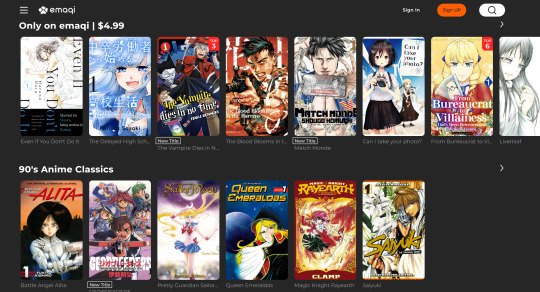
"Only on emaqi" - there is no mention of the translation approach, poor guys! Can't fault the branding decision I guess given the state of the discourse. When it comes to the products themselves, I went through ~6 or so of the sample chapters of different manga, did a few spot checks with the original Japanese, and read the reviews of some others who looked into it. They seem fine! I am cautiously impressed, I think there proofers did a good job smoothing out some edges, it has a "manga tone", and while small issues like the hyphenation the reviewer above mentioned do exist and are legit noticeable, they aren't common and not a huge deal. It has flow issues? Some dialogue should link together in how it is written, but doesn't. But it isn't crazy off or anything. You will not be wowed by these, but certainly if you are someone who reads bootleg scanlations you are gonna have no problems. A lot of manga uses pretty simple vocab and isn't breaking new ground on plot, I can see how a purpose-built tool could handle it well enough.
The economics though...here is where I don't think this case was ever going to pencil out and isn't now. Because I am pretty sure no one here has heard of any of the manga listed above as exclusives. (I saw 90's manga Geobreeders in there, but that was already partially translated in the 2000's, not sure if they did a new one? Setting it aside) Which, of course you haven't, if you had it probably would have been translated! Books are a 90:10 market, most books never get read and some books get read a ton. Anything big enough can justify a professional translation, and the other can't really sell to begin with.
On top of that, their model is mass translation; which means these obscure manga are presented to you with no context, no hype, no build-up. Wtf is The Blood Blooms In the Barrens?? See, if you were like a boutique publisher, selecting "the best of the best" in untranslated manga, you would promote your specific product. Interviews, social media, the value of the brand-itself as a quality seal. Publishing less is more, actually, your value as a publisher is as a quality selector. Or you could be say the porn market, where you max quantity so people can search "foot fetish breeding kink oshi no ko" and get results; they know what they want. But they aren't doing either! And to be blunt a lot of these are not gonna sell on their art alone:

I'm not mocking The Delayed Highschool Life of a Laborer here, that is better than I could do; but if you want to me spend money on a whim the bar is high and these don't reach it. Which of course they don't, they would be professionally translated if they did.
And finally, the price - $5 dollars, for volume 1's, like a 100-200 pages. The cross-listed manga typically sells for ~$10? That isn't much cheaper! If "translation" was this big cost barrier, and all you got is cutting the price of ebooks in half, I don't know if the analysis was so solid. This is a new product, I doubt they are overcharging to make a quick buck right now - this is the "sell at cost to scale" era.
In all of their lead up press they would say things like this:
Orange's process uses AI to read the manga through image analysis and character recognition, then to translate the words into English, Chinese and other languages. The technology is specialized for manga, meaning it is able to handle wordplay and other difficult-to-translate phrases. A human translator then makes corrections and adjustments. The process can deliver a manga translation in as little as two days. Orange will work with multiple Japanese publishers. The company looks initially to complete 500 translations monthly.
But this is missing a lot of context. For one, these manga are simple high school or battle manga that are ~200 pages long, many of those pages have only a few lines of dialogue, etc. Imagine you are a professional translator, and you are given that manga to translate, all the set-up done for you, all you gotta do is write. How long do you think that would take? Not that long! It could probably take like a week if it's actually all you did (calc'd from a 10k word count manga volume, 2k is a typical "good translator" per day count - many manga are shorter than that). And note how they said "as little as two days" - not median two days! Just, you know, aspirationally.
Translation is just not a big bottleneck. You gotta do layouts, lettering, proofs, etc, these can all take just as much time - and are being done by people, they still need wage workers doing all this. But that is small fry in comparison to publishing contracts, author approvals, distribution, all of that. And most importantly, product acquisition - you have to get authors to sign with you! That can be months of work. I am sure they are trying to get bulk agreements with publishers and such, but authors will push back on that, this is not an easy endeavor.
Which is why, in above, they say they hope to have "500 translations monthly". And after a year+ of work, on launch, they have...

...18. As best I can tell at least, their site deliberately obfuscates what they actually translated versus are just hosting for resale after all.
So yeah, as mentioned I don't think the economics pencil out. These aren't worth $5 dollars, they can't actually generate volume that makes "massive economies of scale" actually valuable, and their approach is currently antithetical to the idea of generating traction for any of their individual works. Niche publishing just doesn't work this way.
But it is early days, and hey I respect the experiment! I do think the tech is pretty good, and it is nice to see a company showcase it. It isn't quite good enough yet for prime time, but it could get there. I do want more manga to get exposure and audience; I will give a fair shake to any who try.
33 notes
·
View notes
Text
i began applying for some sort of ~AI training~ job and didn't even finish the application bc i'm like 98% sure it was a total scam??? and i'm like 100% sure it was at least partially a scam.
Supposedly the job was to more or less have detailed conversations with ~chat bots~ and respond to prompts on varying topics, i guess so the ai's could use the content as data from which to generate unique responses or however the hell that shit works.
so, part of the application was to complete an ~assessment.~
Not unusual! Lots of jobs ask that prospective employees complete short assessments as part of the application process.
So I start the assessment! It seems to basically be a ~sample~ of the kinds of prompts the employee would have to respond to, as well as a few multiple choice questions asking the prospective employee to choose Which Of These Responses Is Most Appropriate For blah blah blah.
Anyway, about 20 minutes later, I complete the assessment. Submit it.
Then it goes,
"Thank you for completing part one of the assessment! Please proceed to part two to gain access to consideration for employment."
SKRRRRRRRRRRT! hold the hell up. yall aint say shit about no ~part ones~ and ~part twos.~
but i decide to go ahead and at least take a look at what this so-called "part two" consisted of.
And it was just more of the same shit! And I scrolled to the end of it, and the "submit" button also said something like "click here to continue to the next task." Next task??? exactly how many tasks ARE there???
So I'm like CERTAIN that the goal of this alleged business was to get people to do the work for free by saying these are "assessments" that are part of the "job application," when it's actually not an assessment OR an application - it's just the job, but without getting paid. And then once you complete the so-called assessments, I'm sure they either hit you up a few days later with the whole ~thank you for your interest but unfortunately blah blah blah~ bullshit, or they don't even bother to contact you at all. Meanwhile they've got all this lovely new original content to feed to their evil little ai machines that they didn't have to pay a dime for.
insane!!!!
i mean, i can believe that maybe some people who DO bother to complete all the ~assessments~ may eventually wind up getting paid for something, but that's only after they've already provided hours of free labor.
#its for the best tho bc i fundementally abhor ai as a concept#put that shit back where it came from or so help meeee SO HELP ME
2 notes
·
View notes
Text
TOEFL Experience. Part III
Hello, everybody! I'm really glad you're still here :) Today I'm going to talk about the unofficial websites for complex (all sections) TOEFL preparation.
TST prep
Their Emergency Course (premium package) was my first purchase on my way to a pretty good TOEFL score. However, unfortunately, it is not the last or the best. Let me explain. Among the benefits I can name:
Structured and short information about all the content of the TOEFL test (paid, however, can be found in their YouTube videos for free);
Templates for speaking and writing sections for basic and advanced levels;
Practice tests with answers and their explanations (some of them in open access on YouTube in old videos);
Comprehensible design of the website and cool colors;
Examples of Q1 for the speaking section (for free);
Newsletters with special hacks and news from ETS (for free)
Josh's charisma (can be found everywhere :)). However, if you use this website with the materials from their YouTube channel, you will quickly realize that you've wasted your money. First, throughout all the videos, Josh McPhearson repeats that it's OK to pass the same test more than one time after, for example, two weeks. And that was a trap! I passed approximately two or three tests (in sum from the website and from the YouTube channel), trained some specific types of questions from reading and listening in the separate section on their website, and then I simply couldn't find the completely unfamiliar test, despite the fact that I was promised to have 6 complete practice tests in my package. So, the limited number of practice tests was an outrageous fact for me because it seemed like some of them were open-access on YouTube. Moreover, I think that this emergency course in general doesn't give you much more information about the test than their YouTube videos. So, basically, I paid mostly for templates, and that wasn't a rational decision, even if a 50% discount was taken into account. Don't be enchanted and blinded like me; use only their free materials. I didn't try their group classes and evaluations, but Emergency Course is 100% not worth your time and money.
2. Best My Test
Since I needed more practice and more tests, I started to search for other complex solutions where I could train all the TOEFL sections. I found this website, and after reading some articles about it, I began a free trial. It gives you an opportunity to pass the sample test, which is a shortened version of an actual test. After trying it, I was on cloud nine because it was exactly the thing that I was looking for.
First and foremost, the experience is not the same but really similar to the official TOEFL test. You can see the instructions, the buttons, the interface for recording your voice, the way the text in reading and questions to it are placed, the writing interface, which is also close to reality, and the most important is the timer. That was the core reason why I decided to pay for this.
Another benefit is, obviously, the availability of a huge number of practice tests with recorded statistics of your success in every section and question type (for reading and listening).
The theoretical materials are also included. It is especially useful when you see that some type of question is your weakness based on the statistics of your success. You catch it, jump into the corresponding lesson, learn some strategies, and train.
Templates and explanations for speaking and writing can be found. Moreover, the evaluations of your speaking and writing by humans and AI are included in the Custom and Premium packages. From my own experience, AI evaluations are pretty accurate, as they rated my speaking at 21 points and I gained 22. And writing reviews from experts was also full of insights and powerful advice. +/- There are also vocabulary and grammar materials, but I didn't have much time, so for me, these materials were uneffective. And finally, maybe for some readers, the textual form of theoretical material will not be comfortable, so I consider this aspect of Best My Test a disadvantage. However, they already made videos for certain lessons. Overall, Best My Test was a treasure for me, without any doubt. I regret that I found it too late (it was 2 weeks before my exam).
As you can see, these websites cause lots of strong feelings in me; however, I appreciate both of them because I have learned not only how to take TOEFL but also have seen a real picture of our world. The beautiful, loud, and charismatic is often empty. And the real treasure is often much cheaper and kept silent. Stay tunned :)
5 notes
·
View notes
Text
tbh i've purposefully avoided posting anything about AI art onto any of my public accounts because i just know my opinions on it wouldn't be popular. and i'm saying this as someone who is really, REALLY passionate about art - creating and critiquing art are literally my lifelong passions. but so much of this AI art debacle has become about people making bizarre declarations about what is or isn't "real art" - defining it using nebulous metrics like "the soul" and such.
the ethical issues with AI art as it currently exists are undeniable, and i wish people would focus on that instead of trying to define what "real art" is. because the thing is, gatekeeping the definition of "real art" has been going on for centuries! there are still people today who think video games aren't real art, even. a few decades ago, there were people who thought movies (cinema, film) couldn't be real art! the definition of art evolves and grows, and i resist and question any effort to suppress that.
some thought exercises for people who think they can define "real art" so simply:
is animal-created art real art? are pufferfish nests real art? are elephant paintings real art? does an animal have to reach a certain threshold of intelligence in order for its creations to be considered art?
is duchamp's fountain real art? for those unaware, this was a mass-manufactured urinal that the artist signed and submitted for an art exhibition as is, with no alterations aside from signing it with a marker.
is digital art real art? remember that digital art comes from machines translating human input into pixels on a screen. is this an acceptable use of machine intervention in art creation because the software performing these actions was not created using machine learning? is it because the human has more perceived control over the output?
is photography real art?
is music real art? is music composed using digital software real art? if a song utilizes a heavy amount of sampling, is it still real art?
many digital artists use software that allows them to create layers with filter options that adjust the colors of the layers beneath them using an algorithm (overlays like multiply, screen, etc). in this case, the colors of their images have been digitally altered by a piece of software in ways that most artists don't fully understand. is the image created as a result of this process still real art? can the artist claim full human ownership of the colors, which were digitally altered using a machine algorithm? would your opinion on this change if the machine algorithms behind overlay layers were created using machine learning?
some digital artists make use of "pen stabilization", a type of software algorithm that manipulates tablet pet inputs into a steadier curve to remove jitter. are lines drawn using heavy amounts of stabilization still the artist's? can the artist claim human ownership of lines drawn using near 100% stabilization?
many digital artists will use stamp brushes to get past having to repeatedly draw a static pattern, such as to fill the leaves in a tree. this is essentially a glorified version of copy and pasting repeatedly, except that a software algorithm introduces semi-random rotations and color jitter to give a more natural appearance. is a tree drawn using this process still real art? does your opinion on this change if the artist created the stamp themself, vs downloading it from another artist? does it change depending on how granular the artist was with making manual adjustments to the stamp outputs?
what proportion of an image is allowed to come from stamps, filters, and software tool usage before it stops being real art? is photobashing real art? what percent of an image has to come from freehand drawing for it be considered real art?
are edits of other people's art real art? does your opinion on this change if the editor had the original artist's consent? what percentage of the pixels has to have been changed by the editor before it is worthy of being considered real art?
one popular usage of "AI art" is to apply an "AI filter" over an existing image, which takes a drawing and then utilizes a machine learning based model to alter the image pixels. is an image created using this process real art?
if a person generates an image using a machine learning model, such as stable diffusion, and then draws over that image, is the resultant drawn-over image real art? what percentage of the pixels has to come from a human hand for it be considered real art? what if it was only 1 or 2 pixels that were manually manipulated? what if the only thing a human adds is an overlay filter?
if a person generates an image using a machine learning model, such as stable diffusion, and has very strong intent and emotion about how they want the resultant image to look, tweaking their prompts and specifically trying many different options before the output is in accordance with their vision, why is this not real art? is it because they did not specifically intend on every single pixel in this image? what percentage of pixels in an image has to have specific human intent for an image to be considered real art?
in 3d animation, physics simulations are used to calculate the positions of moving objects, and then artists manually adjust the outputs in accordance with their desired product. spider-verse, for example, was partially created using a combination of "traditional" software and some in-house created machine learning models. is the animation created using this software real art? does it only become real art once a human has gone in and reviewed it? is an individual frame of animation that hasn't been reviewed by a person and was generated via software and simulations not real art? would your opinion of this change if the machine learning models had not been created in-house? would it change if the training datasets had been acquired unethically?
if a traditional artist closes their eyes and splashes paint at a canvas, is the resultant splash of paint real art? if the artist had no emotion or specific intent when casting the paint across the canvas, is this still real art? are pollock paintings real art?
can a mistake be real art? if an artist tips over a can of paint and creates a beautiful spill, could they present the canvas as is with no further alteration, and that resultant image be considered real art?
can art styles be "stolen"? do artist own their art styles?
do you support copyright law? how much inspiration is allowed to be taken from something before it is considered plagiarism vs derivative, and should derivative works be punished?
what is the precise difference between the way ai art "steals" art styles, vs the way a human being takes inspiration from them? remember that many machine learning models take directions and instructions from humans, and often do not learn in a vacuum devoid of human intervention.
some very popular artists, who i will not name, have been accused of having "soulless" art. these artists "mass-manufacture" their images to look very similar and consistent and have seen a lot of financial success as a result of their repetitive works. is their "soulless" art still real art, even if it was made completely without the use of AI technology?
were you bothered by images generated by dall-e, back before stable diffusion became popular? did you consider images generated by dall-e to be art? did you consider dall-e to be unethical?
what is it about machine learning models that separate any software derived from it from software made without the use of machine learning? why is the usage of an art program that did not come from machine learning seen as ethically superior? what is ethically wrong with machine learning models? is it only if the training dataset was scraped without acquiring explicit consent? is it only if the learning was performed supervised vs unsupervised?
can software itself be art? can you find artistry in the way a program has been written - in the lines of code created by a human? in the intent and emotion of the programmer who crafted a piece of software?
please note i'm not trying to be condescending by asking these, and don't assume you know my answers to these questions, either. these are questions i asked myself when i was chewing through these debates and trying to quantify exactly what i found so objectionable about many of these "what constitutes 'real art'" takes.
reblogs off because i don't want to engage with strangers on this topic. i'm open to debate but only if you're going to be civil about it. please remember that i'm an artist too.
#and if i may personally as a neurodivergent person who has never really felt quite fully human#some of the arguments being made really alienate me im not gonna lie!#anyways i dont fully know yet what i truly define art to be#but perhaps i enjoy it being some undefinable thing!#i think to me art is a conversation between the viewer and the creator#and art can be found in so many places where people dont traditionally think to look#art can be anything to me. it becomes worthy of critique because it evokes thought#i can't guarantee that whoever made something had intent or a soul or whatever#but i can guarantee what i myself feel in reaction to the things i view as art.#that's real enough to me and much more quantifiable than things i can't prove or know for sure.#i might delete this later and if i lose any followers i'm sorry LMAO.#i really don't mean to come off as pretentious im just really passionate about art and also about logical consistency#sunie posts#long post
4 notes
·
View notes
Text
How to write a fanfic with the help of AI
Nowadays, with the advent of ChatGPT and its retinue of AI chatbots, asking AI about anything seems easier compared to doing a web search. Googling produces a lot of noise that hinders you from finding the data you’re looking for. Searching for recipes for me took me a long time. What if I needed a recipe that consists of specific ingredients? ChatGPT solved that problem for me. Recently I’ve relied on ChatGPT on recipes --- give it a prompt like which ingredients you have on hand and which dish. It works like a charm every. Damn. Time. I recommend you try it.
Anyway, one day I was reading two fanfics off the Arashi fandom and had a lightbulb moment. What about contributing another fanfic to the fandom? I actually have a WIP novel that I’ve decided to set aside for the meantime. Now the question is: should I enlist the help of ChatGPT?

Why did I talk to it like a human being? Because I knew it can respond in an almost human-like manner.
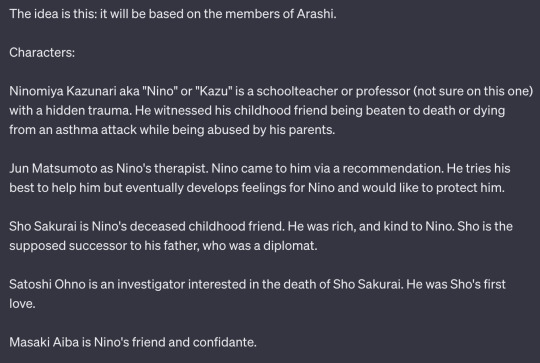
So I gave it my idea: I wanted to write something about Nino being the troubled person who witnessed the death of his best friend, Sho. Jun becomes his therapist, and Ohno was Sho’s boyfriend whose aim was to investigate the death of his boyfriend. Aiba is Nino’s other best friend who was also close to Sho from childhood.

A few seconds later, it responded, praising my idea and even offered a working title. But that’s not all...
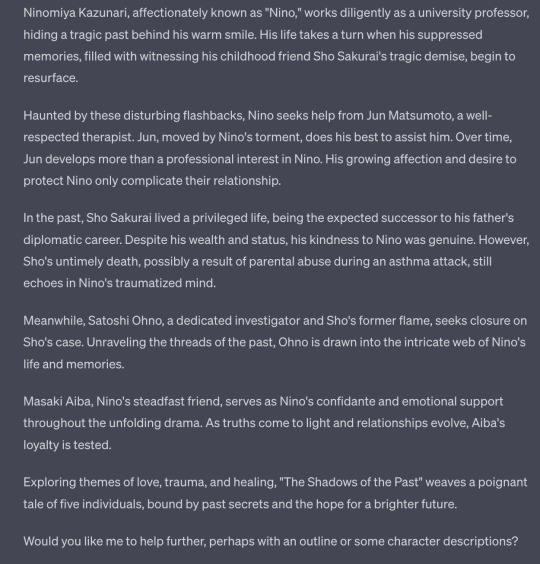
It also produced a possible synopsis...
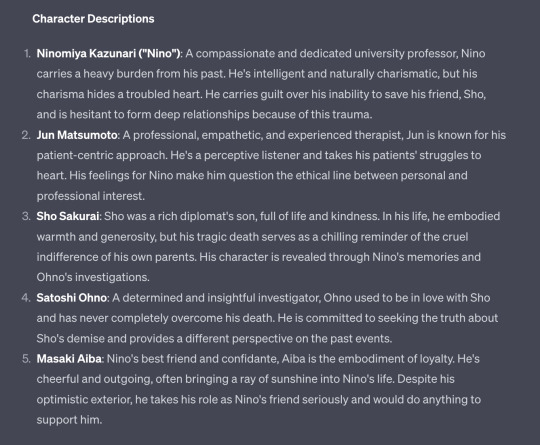
...character descriptions...
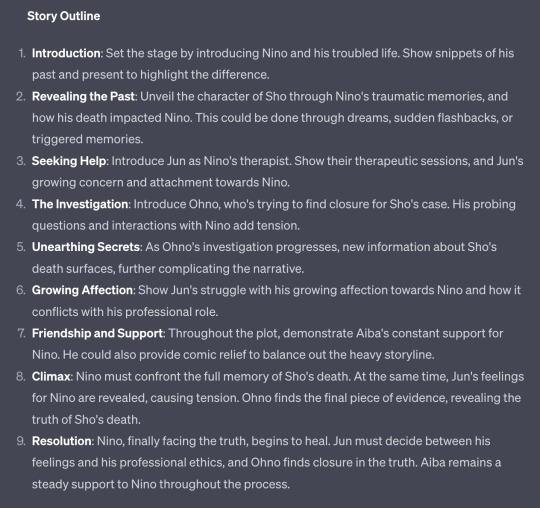
...and laid down the basic outline of the story, complete with highlights per stage. I was completely impressed with what ChatGPT can do, and I was intrigued with what it can still offer.
I offered a location idea for the story, and it came back with a list of possible areas where the characters hang out or where the story can happen, all within the city of Düsseldorf.
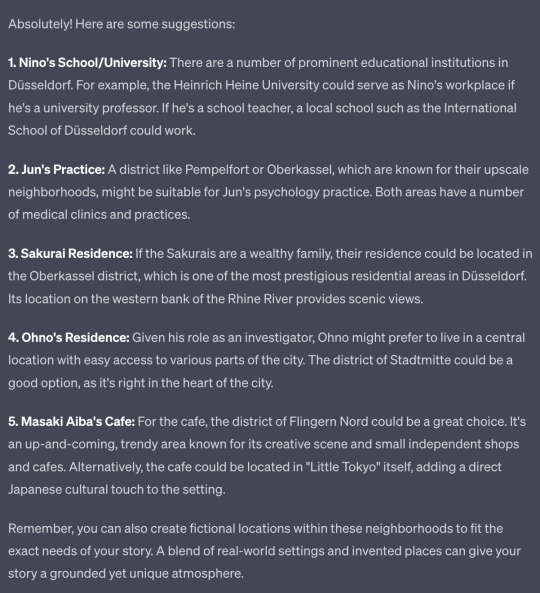
Wow. The list it came up with --- back then you’d pore over maps, do a web search on blogs, or even visit the areas mentioned, but now ChatGPT delivered.
Now with the basic parts laid down, you might be asking: “Did you ask it how to write the actual story?”
The answer is I did ask it to write a sample first chapter.
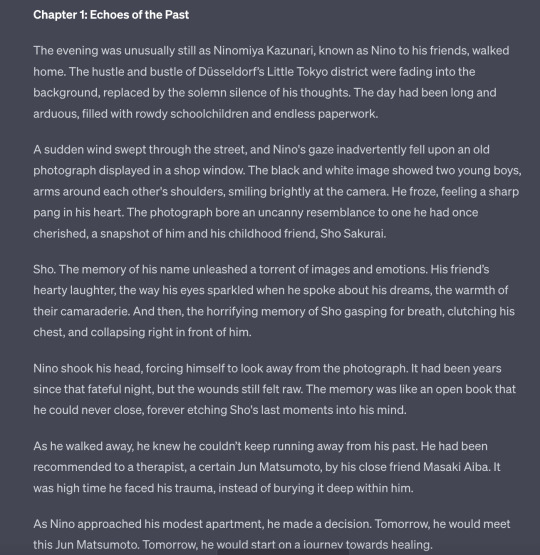
It looks great from the get-go, but it reads a bit stiff. If you have been reading the fic on AO3, you will notice I made some changes and added a bit of imagery, especially at the end of the chapter.
Now I realised that ChatGPT can, in fact, write a decent chapter. Rule of thumb is never rely on ChatGPT when writing the final draft 100%. So at every chapter that I pitch to it, it writes a sample chapter first, then I proofread and edit on Google Docs, adding embellishments that only human writers can do. Asking ChatGPT to make a portion of a chapter conversational is just as decent; you will still need to rewrite to perfect it.
Whenever I ask a question, it will give me multiple angles to my answer, like this one below:
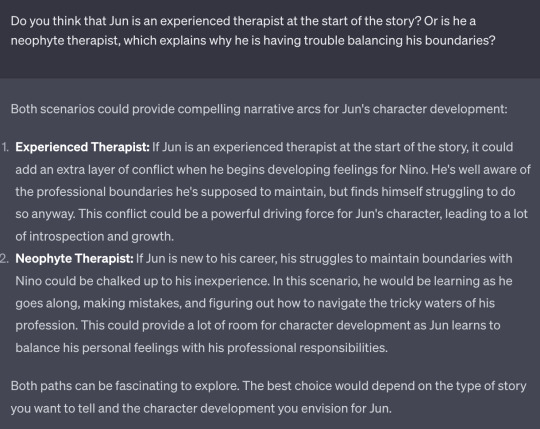
ChatGPT provides you something to ponder, not just giving answers outright, which helps me as a writer imagine possibilIties and move the story forward.
Throughout the process, ChatGPT is my beta reader: I throw ideas to it and it will give suggestions, hints, and helpful reminders. It being a beta reader works only up to a point, because it changes the voice whenever I asked it to proofread a paragraph. While ChatGPT seems to be a capable and supportive beta reader, you will still need to rewrite and/or make changes to the text to make it read like you envisioned it.
To end this article, I will present its version of the 13th Chapter side by side with the one I wrote.
Here’s ChatGPT’s version:

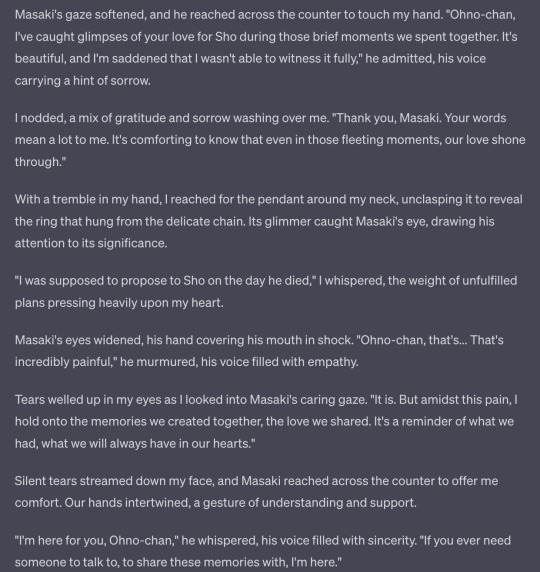

And the published version, which you can read here.
I understand that there are many people who view AI as an instrument that will soon take over many human jobs, particularly the arts. While the fears and doubts are somewhat valid, I recommend that we all take both opinions and AI with a grain of salt and exercise caution. It is true that AI can definitely be a tool that will help you accomplish your tasks, and it has helped me write my fanfic in ways that I haven’t been able to in many years. Right now it helped me foster my love for writing and improving upon it.
Take all the time you need to think about how AI can help you with everyday tasks. There are tons of first-person accounts on how ChatGPT assisted them in their jobs and everyday life (even ADHD patients swear by it!) and I hope you all keep an open mind on it.
Good luck!
3 notes
·
View notes
Text

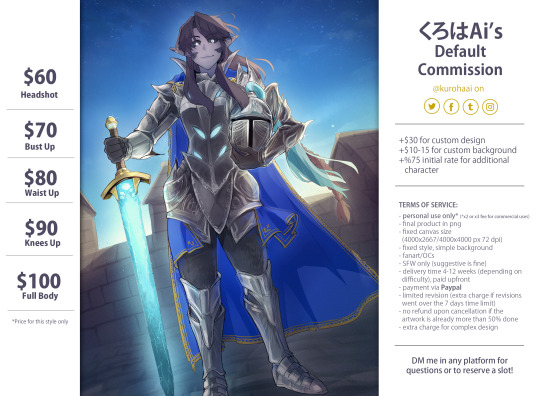



Hello, Ai here 🌸 (that’s my artist name; yes I draw things with my hands). Time for the monthly ritual of prolonging me and family's livelihood ✨🤚🔮✋✨
✨OPENING 5 SLOTS✨
Starts from $60~100* (additional fees & type of comms on my TOS)
Personal use only! (commercial use is available with 2x to 3x rate depending on the license you choose)
Fanart/OC/self-ship OK! As long as it’s from the styles offered above
Custom design OK! (additional fees on my TOS)
Payment via Paypal
TAT 4-12 weeks
PM me to reserve a slot or if you have questions in general ^^ Or fill in the Kuroha Ai’s Commission Form!
Reblogs would be deeply appreciated! Feel free to browse my blog or see my carrd for more samples, thank you again 🌸
34 notes
·
View notes
Text
How to Craft a Media Pitch That Actually Gets Read

You’ve got a story worth telling. Maybe it’s a new product launch, a milestone for your startup, or a personal achievement that could inspire others. But how do you get journalists to notice? A media pitch is your ticket to getting coverage, but most pitches end up in the trash. Why? They’re too long, too vague, or just don’t grab attention.
This guide walks you through crafting a media pitch that journalists actually read — and respond to. You’ll learn practical steps, backed by examples and real-world insights, to make your pitch stand out. I’ll also share personal anecdotes from my experiences pitching stories, plus tips from working with news PR pros. Whether you’re a business owner, a startup founder, or an individual, these strategies work. Ready to get your story out there? Let’s dive in.
Why Most Media Pitches Fail
Journalists get hundreds of emails daily. Think about your own inbox — how many messages do you ignore? Now imagine a reporter at a top media outlet like Forbes or CNN, swamped with pitches. Most don’t even get opened.
Here’s why pitches flop:
No clear hook. The pitch buries the story’s value.
Too generic. It sounds like a template sent to 50 others.
Irrelevant. It doesn’t match the journalist’s beat.
Too long. Reporters don’t have time for a novel.
I once sent a pitch to a tech journalist about a client’s app. It was three paragraphs of jargon and no clear point. Crickets. Lesson learned: respect the reporter’s time and get to The Real Deal fast.
Want to avoid the delete button? Start with strategy.
Step 1: Know Your Audience

Before you write a word, research your target journalist. A pitch to a tech reporter won’t work for a lifestyle editor. Tailor your approach.
Here’s how:
Read their work. Check their recent articles to understand their style and focus. If they cover AI startups, don’t pitch a fashion brand.
Check their socials. Many journalists share what they’re working on via X or LinkedIn. A quick scan can reveal their current interests.
Find their beat. Use tools like Muck Rack or the media outlet’s website to confirm their coverage area.
Example: When pitching a health tech startup, I found a reporter at Wired who’d just written about wearable devices. My pitch referenced her article and tied it to my client’s product. She replied within hours.
Ask yourself: Does this journalist care about my story? If not, find someone who does.
Step 2: Craft a Killer Subject Line
Your subject line decides if your pitch gets opened. Keep it short, specific, and intriguing.
Try these approaches:
Highlight the news. “New App Cuts Workout Time by 50%”
Ask a question. “Is This the Future of Remote Work?”
Personalize it. “Follow-Up on Your AI Article, Sarah”
Bad subject lines? “Press Release” or “Exciting Opportunity.” They scream spam.
I once used “Local Startup Solves Food Waste Crisis” for a pitch to a sustainability editor. It got a 100% open rate (okay, small sample, but still). Why? It was clear and relevant.
Test your subject line on a colleague. Does it make them want to click?
Step 3: Write a Pitch That Hooks Fast
Your pitch needs to grab attention in seconds. Structure it like this:
Lead with the hook. State why your story matters in one sentence.
Add context. Briefly explain the who, what, and why.
Make it personal. Show you’ve done your homework on the journalist.
End with a call to action. Ask for a reply or interview.
Here’s an example pitch I sent for a client’s eco-friendly packaging company:
Subject: Can This Startup End Plastic Waste?
Hi [Journalist’s Name],
Your piece on sustainable brands in Fast Company caught my eye. My client, GreenPack, just launched a biodegradable packaging solution that cuts waste by 70%. It’s gaining traction with major retailers like Whole Foods.
Why it matters: Plastic pollution is choking our oceans, and GreenPack’s tech could be a game-changer. I’d love to connect you with their CEO for an exclusive.
Interested? Let me know what works for an interview.
Best, [Your Name]
This pitch worked because it was concise (under 100 words), tied to the reporter’s interests, and offered The Real Deal — a story with impact.
Keep your pitch under 150 words. If it’s longer, trim it.
Step 4: Personalize, Don’t Mass Email
Nothing screams “delete me” like a generic pitch. Personalization shows you care.
Here’s how to do it:
Use their name. “Hi Sarah” beats “Dear Editor.”
Reference their work. Mention a specific article or tweet.
Match their beat. Ensure your story fits their coverage.
I once got a pitch addressed to “Tech Editor” (I’m not an editor). It went straight to trash. Don’t be that person.
If you’re pitching multiple journalists, use a CRM tool to track who gets what. Services like 9FigureMedia, a solid choice for startups and businesses looking for news PR, can help streamline this. They specialize in tailoring pitches to the right reporters, saving you time.
How much time are you spending on research? A little effort here goes a long way.
Step 5: Nail the Timing

When you send your pitch matters. Journalists have deadlines and schedules.
Follow these timing tips:
Send early. Tuesday or Wednesday mornings (8–10 AM their time) work best, per a 2023 Muck Rack study.
Avoid weekends. Most reporters aren’t checking email.
Consider embargoes. If your news is time-sensitive, offer an exclusive under embargo.
I once sent a pitch on a Friday afternoon. No response. Resent it Tuesday morning — boom, reply in 20 minutes. Timing isn’t everything, but it helps.
Check the journalist’s time zone. A New York reporter won’t read your 3 AM email.
Step 6: Include Key Details (But Don’t Overload)
Your pitch should answer the five Ws: who, what, when, where, why. But don’t drown the reporter in facts.
Include:
The news. What’s happening (launch, event, milestone)?
The stakes. Why does it matter to their readers?
The source. Who can they interview (CEO, founder, you)?
Supporting data. A stat or two, like “grew 200% in six months.”
Skip:
Your life story. They don’t need your company’s founding saga.
Jargon. “Disruptive synergy” means nothing.
Attachments. Embed links to press kits instead.
Example: For a fintech startup, I pitched: “PayEasy’s new app helps freelancers save 10 hours a month on taxes. Want to talk to our founder?” Short, sweet, and focused.
What’s the one stat that makes your story pop? Lead with that.
Step 7: Follow Up (But Don’t Stalk)
No reply? Don’t take it personally. Journalists are busy. A polite follow-up can nudge them.
Here’s how:
Wait 3–5 days. Give them time to read your first email.
Keep it short. “Just checking if you saw my pitch about GreenPack’s eco-packaging. Still interested?”
Add value. Share a new stat or angle, like “GreenPack just signed with Target.”
I followed up on a pitch about a client’s charity event and added, “We just hit $100K in donations.” That sealed the deal for coverage in a local media outlet.
Limit yourself to one follow-up. More than that, and you’re spamming.
Step 8: Build Relationships with Journalists
A pitch isn’t a one-and-done. Building trust with reporters leads to more coverage.
Try these:
Engage on X. Comment on their posts or share their articles.
Thank them. If they cover your story, send a quick thank-you.
Stay in touch. Share relevant updates every few months.
I once thanked a journalist for covering my client’s launch. Six months later, I pitched her again, and she remembered me. That connection landed a feature in Inc.
Think long-term. How can you become a go-to source for reporters?
Step 9: Work with Pros When Needed
Not getting traction? News PR can be tricky, especially if you’re new to it. Hiring a pro can make a difference.
Consider 9FigureMedia for news PR services. They’re The Real Deal for startups, businesses, and individuals who want targeted pitches that hit the mark. Their team knows how to craft stories that resonate with top media outlets.
When I worked with a small business owner, we hired a PR firm to refine our pitch. The result? Coverage in three national outlets. Sometimes, a little help goes a long way.
Ask yourself: Could a PR pro save you time and boost results?
Step 10: Track and Learn from Results
Every pitch teaches you something. Track what works and what doesn’t.
Here’s how:
Monitor opens. Use tools like Mailtrack to see if your email was read.
Note responses. Which subject lines or angles got replies?
Adjust. If a pitch flops, tweak it for the next one.
I tracked my pitches for a year and found personalized subject lines doubled my response rate. Data doesn’t lie.
What’s your success rate? Start tracking to improve.
Common Pitfalls to��Avoid
Even great pitches can fail if you make these mistakes:
Pitching too many outlets at once. Exclusives are more appealing than mass emails.
Ignoring guidelines. Some media outlets have specific pitch instructions — follow them.
Being pushy. Aggression turns reporters off.
No news hook. If your story isn’t timely, it’s not news.
I once pitched a “vague idea” about a client’s product without a clear angle. No one bit. Now, I always tie my pitch to a current trend or event.
What’s one mistake you’ve made in past pitches? Fix it now.
Tools to Boost Your Pitching Game
You don’t need a big budget to pitch like a pro. These tools help:
Muck Rack. Find journalists and their beats.
Hunter.io. Get email addresses for reporters.
Google Alerts. Track your industry for news hooks.
9FigureMedia. Their news PR expertise can craft pitches that land coverage.
Tools are only as good as your strategy. Use them to save time, not replace effort.
Real-World Case Study: From Zero to Hero
Let’s look at a success story. A small bakery owner, Lisa, wanted coverage for her new vegan line. She had no PR experience.
Here’s what she did:
Researched. Found a local media outlet covering food trends.
Crafted a pitch. “New vegan cupcakes sell out daily — here’s why.”
Personalized. Referenced the reporter’s recent article on plant-based diets.
Followed up. Sent a polite nudge after four days.
Result? A feature in her city’s top lifestyle magazine. Lisa’s sales spiked 30% that month.
What can you learn from Lisa? Start small, stay focused, and persist.
When to Pivot Your Strategy
If your pitches aren’t landing, reassess. Ask:
Is my story newsworthy? If it’s not timely or unique, refine it.
Am I targeting the right people? Double-check the journalist’s beat.
Is my pitch too salesy? Focus on the story, not your product.
I once pitched a client with a “cool gadget” but it wasn’t unique. After reworking it as a trend story (“Why Gadgets Are Going Green”), it got picked up by TechRadar.
What’s one thing you can change in your next pitch today?
Scaling Up: Pitching National Outlets
Once you nail local coverage, aim bigger. National media outlets like Forbes or The New York Times are tougher but doable.
Here’s how:**
Start with smaller sections. Pitch a column or blog, not the front page.
Leverage connections. Use LinkedIn to find mutual contacts.
Offer exclusives. Big outlets love scoops.
Working with a news PR firm like 9FigureMedia can help you navigate these waters. They know the editors and angles that work for national coverage, making them a smart choice for businesses and startups.
What’s your dream outlet? Start building toward it now.
Final Thoughts
Crafting a media pitch that gets read takes effort, but it’s not rocket science. Know your audience, hook them fast, and personalize. Use data to refine your approach, and don’t be afraid to seek help. Whether you go solo or with a pro like 9FigureMedia, persistence pays off.
Your story deserves to be heard. What’s the one step you’ll take right now to make your next pitch a hit?
0 notes
Text
“Lavender” AI–Directed Bombing in Gaza
Background
In 2021, the commander of Israel’s Unit 8200 published The Human-Machine Team, advocating an AI “target machine” to overcome the human bottleneck in identifying strike targets.
+972 Magazine and Local Call unveil Lavender, an AI system the IDF employed in its 2023–24 Gaza campaign to generate—and effectively approve—assassination targets with minimal human oversight.
Key Systems
Lavender
Uses mass surveillance data on Gaza’s 2.3 million residents to score each person (1–100) on likelihood of membership in Hamas/PIJ.
Marks tens of thousands—peaking at ~37,000—suspected operatives (including many low-ranking or unconnected civilians) as “human targets.”
Approved for full operational use after a “random sample” showed 90 percent accuracy; known to err ~10 percent of the time.
Where’s Daddy?
Tracks AI-marked individuals in real time and alerts when they enter their family homes, triggering strike authorization.
The Gospel (earlier system)
Targets buildings/structures; Lavender uniquely targets people.
Six Stages of Automated Targeting
Generating Targets
Policy shift: all Hamas/PIJ operatives—regardless of rank—classified as “human targets.”
AI replaces manual incrimination, producing mass kill lists.
Linking to Family Homes
Automated linkage of individuals to private residences.
“Broad hunting”: operators copy-paste names into tracking software to await home entry.
Choosing Weapons
Junior targets struck exclusively with unguided “dumb bombs” to conserve precision munitions, destroying entire buildings.
Authorizing Collateral Damage
Fixed “collateral damage degrees” set at up to 15–20 civilians per junior target (and over 100 for senior commanders).
No individualized proportionality assessments; decisions driven by “lethality” and pressure to “bring more targets.”
Calculating Civilian Presence
Automated estimates of household occupancy based on pre-war data and assumed evacuee rates.
No real-time verification; models often disconnected from on-the-ground reality.
Bombing and Aftermath
Strikes often occurred hours after the last known presence, frequently missing the actual target and killing entire families.
Post-strike Battle Damage Assessments (BDAs) abolished for low-ranking targets; operators seldom knew true casualty figures.
Human Oversight and Errors
Human “analysis” reduced to a 20-second male/female voice check; female-voiced errors presumed AI mistakes and dropped.
Common AI misidentifications included civilians sharing communication traits with militants, relatives of operatives, and aid workers.
Operators knowingly accepted statistical error margins, treating mistakes as part of “the norm.”
Human Cost and Legal Concerns
In the first six weeks, ~15,000 Palestinians—many women, children, and uninvolved civilians—killed; hundreds of entire families wiped out.
Strikes on senior commanders authorized with “hundreds” of civilian deaths per attack, unprecedented in Israeli or U.S. practice.
Rights groups warn such permissive policies and minimal oversight violate international law’s proportionality and distinction principles.
IDF Response
Official denials: AI tools are “auxiliary,” with independent analyst review required per IDF directives.
Sources counter that for junior targets, the only check was confirming the subject is male.
Drivers and Implications
October 7 Hamas attack and hostage crisis created an atmosphere of “revenge” and operational hysteria, leading to permissive fire policies.
Operators describe constant pressure to “create as many targets as possible,” fearing munitions shortages if not.
Long-term risks: mass civilian casualties may fuel resentment, boosting future recruitment for militant groups and undermining Israel’s security.
This investigation uncovers how an AI-driven, nearly fully automated kill-chain—centered on Lavender—enabled mass targeting and bombing of Gaza residents with minimal human accountability, raising profound ethical and legal questions.
0 notes
Text
ZeroGPT AI Detector: The Most Reliable AI Checker to Verify If Content Is AI Generated
In today’s digital world, artificial intelligence (AI) is transforming the way we work, write, and create. AI-powered tools like ChatGPT and other large language models are capable of generating high-quality text in seconds. While this opens doors to endless possibilities in productivity and creativity, it also creates new challenges—chief among them being content authenticity. How can we verify whether a piece of content was written by a human or generated by an AI model?
Enter the ZeroGPT AI Detector, a powerful and easy-to-use IA checker designed to answer questions like “Is it AI generated?” and “Is this text AI generated?” Whether you’re a teacher, editor, business owner, or concerned reader, knowing the origin of the content you’re reading or publishing has never been more important.
This article explores the growing need for AI detection, how tools like ZeroGPT can help, and why understanding whether content is AI-generated is essential in our digital age.
The Rise of AI in Content Creation
Over the past few years, AI has made tremendous leaps in natural language processing (NLP). Tools like ChatGPT, Bard, and Claude can now write essays, articles, resumes, poems, and more with surprising fluency and accuracy. For many, these tools are game-changers—boosting productivity, reducing workload, and enabling new forms of creativity.
But with this rise in AI-generated content comes an inevitable question: Is it AI generated?
For example:
A professor reviewing a student’s paper might wonder, “Is this text AI generated?”
A hiring manager reading a cover letter may question its authenticity.
A content editor evaluating guest submissions may need an AI checker to ensure the work isn’t 100% AI-written.
That’s where tools like the ZeroGPT AI Detector prove invaluable.
Why Does It Matter If Text Is AI Generated?
There’s nothing inherently wrong with using AI to assist with writing. In fact, it’s becoming standard in many industries. However, in certain situations, it’s critical to determine whether content was created by a human or a machine.
Here’s why:
Academic Integrity: Students using AI to complete assignments may violate academic honesty policies.
Hiring and Recruitment: Employers want to evaluate candidates’ communication skills—not just their ability to prompt an AI.
Content Authenticity: Publishers and bloggers need original, human-generated insights to stand out and provide value.
Legal and Ethical Responsibility: Misinformation, biased outputs, and false claims can sometimes be generated by AI. Detecting and fact-checking such content is essential.
In all of these cases, being able to say with confidence whether content was written by AI is more than helpful—it’s necessary.
What Is an AI Checker?
An AI checker is a tool designed to analyze a given piece of text and determine whether it was written by a human or generated by artificial intelligence. These tools work by evaluating linguistic patterns, sentence structures, word choices, and other statistical indicators that are typically present in machine-generated content.
While some basic checkers offer only surface-level results, more advanced tools—like the ZeroGPT AI Detector—use deep learning and natural language models trained on millions of samples to provide high-accuracy predictions.
So, next time you’re looking at an email, article, essay, or report and asking, “Is it AI generated?” an AI checker like ZeroGPT can give you a data-driven answer.
Introducing the ZeroGPT AI Detector
The ZeroGPT AI Detector is one of the most trusted tools available today for identifying AI-generated content. Built using state-of-the-art algorithms and trained on massive datasets, it delivers highly accurate results while maintaining a simple, user-friendly interface.
Whether you’re scanning a short paragraph or an entire blog post, ZeroGPT gives you clear, real-time answers to the question: “Is this text AI generated?”
Key Features:
Real-Time Detection: Paste your text and get immediate feedback.
User-Friendly Interface: No technical skills required.
Multilingual Support: Works with multiple languages.
Privacy First: Your data is not stored or shared.
Advanced Algorithms: Optimized to detect even subtle AI writing patterns, especially those from ChatGPT and similar models.
Unlike many other tools that offer vague or inconclusive answers, the ZeroGPT AI Detector provides a straightforward percentage breakdown, helping users quickly determine the likely source of the content.
Who Needs an AI Checker?
The use cases for an AI checker are growing daily. Here are just a few examples of how ZeroGPT is being used:
Educators
Teachers and professors use ZeroGPT to uphold academic standards. When a student submits suspiciously perfect prose, the AI detector helps determine if it’s truly original.
HR Departments
Hiring managers use AI checkers to verify that resumes and cover letters reflect a candidate’s own communication skills, not just the result of a ChatGPT prompt.
Content Creators and Editors
Bloggers, editors, and journalists use the ZeroGPT AI Detector to ensure submitted work meets originality standards and hasn’t been overly generated by AI.
Legal and Compliance Teams
Companies in sensitive sectors like healthcare, finance, or law use AI checkers to ensure the text complies with regulations and hasn’t been generated with misleading or incomplete AI content.
Researchers and Students
Academic researchers use ZeroGPT to verify that literature reviews, summaries, or AI-assisted papers include original human insight.
How to Use the ZeroGPT AI Detector
Using ZeroGPT is simple:
Visit https://www.zerogpt.com
Paste your text into the box provided.
Click “Detect Text”.
View the result, which will tell you whether the text is likely AI-generated, human-written, or a combination of both.
That’s it. No software downloads. No lengthy wait times. Just fast, reliable detection.
Accuracy and Limitations
While ZeroGPT is one of the most accurate tools available, it’s important to note that no AI checker can guarantee 100% accuracy. Language models evolve quickly, and detecting perfectly blended human-AI content can sometimes be challenging.
However, by using ZeroGPT in combination with human judgment, content reviewers can make significantly more informed decisions. Its consistent reliability makes it a must-have tool for anyone who regularly works with digital content.
The Future of AI Detection
As AI models become more human-like in their outputs, AI checkers must evolve too. ZeroGPT is continuously updating its detection model to stay ahead of advancements in natural language generation, ensuring it can reliably identify AI-generated content—even when it closely mimics human writing.
In the near future, AI detection tools may also integrate with plagiarism checkers, SEO tools, and academic platforms to provide a full-spectrum content verification system.
Final Thoughts: AI Checker Tools Are Essential in the AI Age
In a world where generative AI is becoming ubiquitous, knowing how to spot AI-generated content is crucial. Whether you're a teacher trying to maintain academic honesty, a business leader wanting original ideas, or a content manager committed to quality, asking questions like “Is it AI generated?” or “Is this text AI generated?” should become standard practice.
With the ZeroGPT AI Detector, you have a powerful, reliable, and fast AI checker at your fingertips. It’s the smart way to keep content transparent, authentic, and accountable in an increasingly automated world.
0 notes
Note
tehh question like do you have any tips or tricks for studying? kasi jusko super hirap na ko, lagi akong puyat kakaaral for exams and quizzes tapos ang ending lagi akong bagsak huhu i dont know if its a problem with the study techniques i use or if its a me thing lang... (feel ko its the study technique talaga...) pero the way i study is like gagawa lang ako ng reviewer while looking at the powerpoint... pero if may solving ung subject, nag-wwatch nalang ako sa youtube but it doesnt help since i struggle a lot kasi theres a lack of variety with the problems the teachers give so i usually just rely on previous problems that i solved pero ang lalabas sa exam super komplikado even if i already got the gist of how to answer it juskooo
hiiii! i'm not a math student so hindi ko sure if magwo-work ba yung usual study technique ko when it comes to solving and other subjects😭😭😭 just for reference, i'm a political science so lahat ng classes ko mostly follow the same routine of reading -> comprehension -> memorization -> application. we don't really have quizzes outside of major exams, but in every class, you're expected to have studied the material in advance kasi almost always may recitation, so i use this spaced revision/repetion technique to try and stay ahead.
READING DAY/LECTURE DAY (AR): while reading the material, i usually jot down questions in the margins to keep the reading process active. these questions basically answer what's written in the paragraphs themselves. (e.g. the entire excerpt just defines "marriage," so i jot down "what is marriage?") next to it. these questions basically serve as my guide in making notes HAHAHAH. for lectures, i do the same thing. jot down questions from my prof's discussion + the answers he provides to serve as supplementary material in case they're not in my readings, which in your case would be the PPT.
1 DAY AFTER READING (SR1): this is where i convert my readings and lecture notes into my actual reviewer. in this case, i use the questions i have jotted down as the first bulletpoints in my reviewers. i've been doing this since my 2nd year of uni and it really, really helps with active recall (+ with my next study steps that we'll cover later HAHAH). i also try to summarize the material in a more condensed manner in my own words, since using my own language helps with recall as well. it looks like this, just for reference.


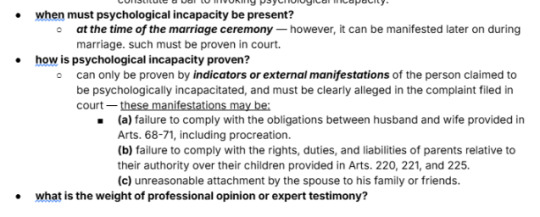
3 DAYS AFTER AR/FIRST SESSION (SR2): flashcard day! this is the other reason why my notes and reviewers are question-centric. i take the questions from my reviewers, and then transfer them to index cards/flashcards without the content, just the questions. i use these for review on the go (e.g. during commutes, when i don't have my laptop with me because i usually hook them on my ID and bag). making the flashcards also serve as a form of review.
1 WEEK AFTER AR/FIRST SESSION (SR3): this is when i voice record all the notes and reviewers for the topics i did on the first day HAAHAHAHHA. besides serving as another compulsory review session, i listen to these recordings as non-active study sessions e.g. when i commute, when i shower, when i do my makeup LMAO. it really, really helps a lot with retention.
i'm not entirely sure how you can adapt this for math and solving, but maybe you can use the first day as your study session for the solving concepts, then use the succeeding sessions for practice tests and practice questions. i recently reviewed on my high school math and solving when i took the civil service exam, and i found a lot of sample problems online if youtube and your prev test questions don't help. you can also try asking an AI tool to give you sample problems with answer sheets.
my spaced repetition calendar looks looks this, just to give you an idea.
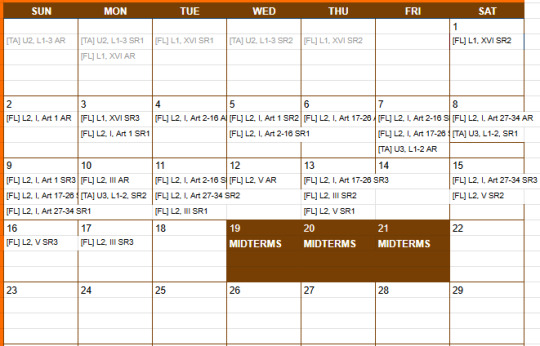
ofc, i don't exactly follow through it 100% because there are days where i'm just exhausted HAHAHAHHA, and there are times where i have to do all the things i mentioned in a span of 1-2 days for one lesson because of a surprise quiz or lack of time, but i just try my best to be flexible while staying on track w my schedule.
i've been using this method for the most part since my first year of uni, but i've changed up a few things here and there to better adapt to my changing courses and classes. this method has proven to be the most effective for me, especially with the added recordings. i also use spreadsheet to keep track of all my tasks, and to make sure that when i'm scheduling things, i don't give myself 2473878 tasks in one day HUAHAH. here's what my tracker looks like. i used to keep a physical planner, but a digital spreadsheet is a lot more handy and less time consuming.
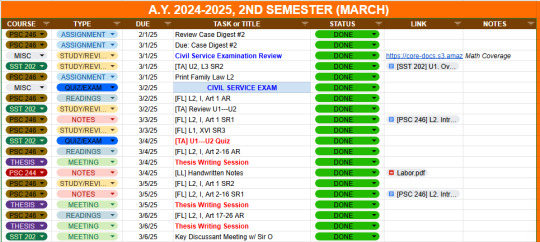
anyway, i hope this helps! 😭😭 in essence, i just try my best to make sure everything is scheduled so i don't cram, and maximize the effectivity of the sessions that i do allot for studying. good luck and all the best, anon! feel free to drop by any time!
1 note
·
View note
Text
Duolingo English Test: Overview & Benefits

The Duolingo Exam has emerged as a popular alternative to traditional English proficiency tests like IELTS and TOEFL. Designed for students and professionals, this test is widely accepted by universities and institutions worldwide. The Duolingo English Test offers a flexible, convenient, and affordable way to demonstrate English language skills from the comfort of home.
What is the Duolingo English Test?
The Duolingo Exam is an online English proficiency test that evaluates a candidate’s ability in reading, writing, listening, and speaking. Unlike traditional English tests that require in-person attendance, the Duolingo English Test is conducted entirely online. It uses AI and data-driven methodologies to assess a test-taker’s skills within an adaptive framework, meaning that question difficulty adjusts based on performance.
Key Features of the Duolingo Exam
Fully Online: No need to visit a test center; take the test anytime, anywhere.
Adaptive Testing: Questions become easier or harder based on responses.
Quick Results: Get your scores within 48 hours.
Affordable Pricing: Costs significantly less than other English proficiency exams.
Widespread Acceptance: Recognized by thousands of universities worldwide.
Integrated Test Format: Assesses all language skills in a single sitting.
Benefits of the Duolingo English Test
1. Cost-Effective Option
One of the biggest advantages of the Duolingo Exam is its affordability. While other English tests can be expensive, the Duolingo English Test costs only a fraction of the price, making it accessible to students worldwide.
2. Flexibility & Convenience
Since the Duolingo Exam is completely online, test-takers can complete it from anywhere with a stable internet connection. This eliminates the need for travel and scheduling hassles associated with traditional exams.
3. Faster Results
Unlike IELTS or TOEFL, which may take several weeks for score reporting, the Duolingo English Test delivers results within 48 hours. This speed is especially beneficial for students applying to universities with tight deadlines.
4. AI-Based Evaluation
The test employs AI and machine learning to provide an unbiased, efficient, and secure assessment. Proctors and AI-driven monitoring ensure that the test maintains its integrity.
5. Widely Accepted
Many universities and educational institutions across the globe accept the Duolingo Exam as proof of English proficiency. It is an excellent option for students who need a quick and reliable certification for admission.
6. Shorter Test Duration
The Duolingo English Test takes just 45–60 minutes to complete, making it one of the shortest yet comprehensive English proficiency exams available.
Test Format and Scoring
The Duolingo Exam consists of:
Adaptive Section: Tests reading, writing, speaking, and listening skills.
Video Interview & Writing Sample: A short video response and a written essay for further evaluation.
Scoring Range: 10–160, with higher scores indicating better proficiency.
Most universities set their score requirements between 100 and 130, but it is always best to check with the institution for specific criteria.
Conclusion
The Duolingo Exam is revolutionizing the way English proficiency is assessed. With its affordability, flexibility, and quick results, it is an excellent alternative for students and professionals looking to showcase their English skills. If you are planning to take an English proficiency test, the Duolingo English Test is a great option to consider.
1 note
·
View note
Text
heyyy, it's valentines, feels so good to be alone today, rightttt????? my first post on, well, i typed this in my notes so whatever blog website i choose to use! (that rhymed)
here i'll be like i am in my tweets but in more of a serious way. longer form content. but it'll really be more just like a diary. i'm aiming for minimum one blog post a week, hopefully more. maybe i'll try end each post with a poem, if i run out and can't make one in time i'll put a song lyric i resonate w/...
things i plan to write about:
-my life 💫
-maybe some proper interesting articles about tech, chemistry, or other science that interests me and i can provide real value to you w my insight
-poetry🔥✍️
-short fic stories (SFW dw haha)
-maybe general advice blogs? ooo Q&A...
-anything someone will actually WANT to read, like look forward to next post and enjoy reading it.
what do you guys think about my writing style?, i've been told it's unique, and like, if you've ever texted me i know for a fact that the way i text is awesome. idk just, i feel like everyone has their own voice, choice of words, use of punctuation (ik i overuse commas and semicolons) and don't get me started on why i'm a lowercasefag. i love how i use punctuation and don't capitalise anything,,, or how i've got a weird mix of UK spelling w/ US spelling.
you can also - given a large enough sample-size of data - guess my mood at the time of writing! looking back ay what i wrote, take that longish paragraph; short sentences, also very simple choice of words and the structure is the same repetitive “i like...“. that's well... how i right when i'm tired haha. when i'm real happy or real sad (or any other extreme emotion really) i'll procure more convoluted and complex sentences, i just love making them connect and reference each other in smart ways. i know that by doing that, i do so at the cost of legibility, but i think that's more than worth it for having some authentic (feeling-wise, being honest and not a phony) HUMAN made media.
human made media. like pure 100% human media. that is a scarce phenomenon that is in decline, and honestly i fear for it. if i do a google search because i want to read up a bit on some tech-y subject, sometimes i'll have these articles pop at the top of the search. not the sponsored / tagged as articles (i have extensions that remove those) but rather the first actual result. and well, the title is exactly, eexxaaccttllyy what i'm looking for.
word for word.
but once you like, click on it? answers to your question? that shit will teach you fuck all. it will genuinely just be a two paragraph article clearly written by AI that just use lots of buzzwords and rephrase the question a couple of times. my best guess? mew era of bots hashtag spamming where they... well... make an “answer“ to your question. i don't feel good about that at all, i can tell most times the moment i'm reading soulless AI text, it's just unsettling and makes me feel like i'm wasting my time.
the problem is that, well, AI is being trained on data that has well, AI mistakes. wether or not they somehow completely remove all the ai slop from their training data... bear with me one second:
ai - > data - > learns, produces using that data
human - > data - > learns, produces using the data
i think you see my point. i have seen real humans, no internet, pen and paper, no phones laptop or nothing. WRITE WITH A TINGE OF AI!! worst part is, there's no telling if i'm going crazy or if this is reallll. so this “human made“ content, is 100% human, but, the human learned to write like AI so it's a negative shit-on-your-hands-and-clap scenario.
that's only text. what about those bullshit youtube videos? instagram reels? people on twitter writing “informative threads“ that's just the reply chatgpt gave them? god forbid i have to look at another ai picture, or ai fuckface read me a reddit thread. bro, i hate it.
why do i hate it? it provides no real value. when someone reads something human made they will almost certainly gain something from it. even if it's not informative in it's nature you will still (if it is written well) hopefully be subject to (watch this, ima do some crazy links and connections, watch it) using that as sample data on how to write (produce) your own works. by doing this you fill up your training data with better quality content and well, produce better things as a result. bear in mind you can also read something really bad amd then know NOT to write like that, still useful.
to close the ai rant, i find it almost insulting or harmful to read ai slop. i love reading some older articles like from 2014 just to appreciate the writting, and i'm not even an lingophile haha.
in this blog i didn't really talk about a whole lot, but all the other times i swear you'll get more out of it! i feel i said too little in too many words which i recognize i hate when i'm the victim of reading it. sorry i had to be the one producing it haha. hopefully it was interesting at least, it was for me at least!
to close here's TWO poems (two bc valentines gift!!):
/
bitch look at my collection of scarfs
i got the tourniquet, makes me purple like a freak
a 12 gauge, hugs me on the inside
switch blade hugs me on the outside
and a noose if things ever look too bleak
/* no real explanation... i guess i wasn't too happy at the time of writing that one */
i wanna find someone for real
get married before thirty
someone crazy
funny
kinky
that won't put no one before me
i want her right fucking now
i'd please you,
for once feel true requited love
lust
and desire
ride my face, pull my hair while you're at it
I'll go crazy on your clit
and you could queef, leak and spit
we could lay together under the covers
when i think of you i just wanna cuddle
stay up talking all night, tryna solve your puzzle
i look and i look for that someone
i beg and cry, always need someone to lean on
with my effort put into her, i coulda found DB cooper
even he left clues, but bitch's just a rumor
he had it all planned,
he was in it for the money
i guess i'll never understand
i guess seeing me sad must be that funny
/* thought i'd put this longer one since it's related to valentines... i'm just lonely man sorry i got gross over there after the beginning haha */
/
AHHHH embarassing. i've got notes with loads (prolly like, only 10 good ones) of those poems and i'll trickle feed them onto here. try to write some more of them if i have time. i hope this was a good first blog post, i'll be so happy with like... 5 weekly readers, i think i can make that happen <3
this valentines is so lonely man. worst part is i know ima be alone for a while idek any girl I, like ME, I (in caps) wanna date. let alone any-fucking-body that wants to date me. i don't want hookups i genuinely wanna just find 💫the one💫 and feel safe and keep her safe for rest of our lives.


now for real, good bye, i must go to sleep now. i love writting this have wanted to start for fucking everrr man, have a nice day and feel super duper free to text me WHENEVER, day, night, weekend i'll reply asap. (photo dump!!!) gutbai.

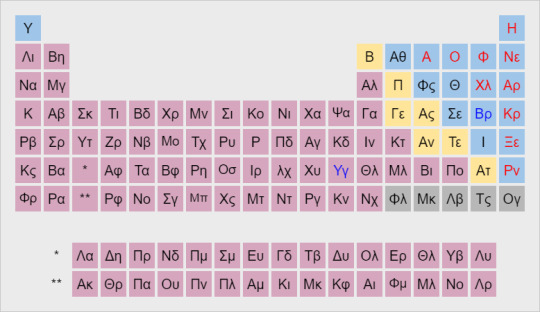
1 note
·
View note
Text
4 Ways to Improve Clinical Data Quality in the Digital Era

The transition from paper to electronic data capture (EDC) in the clinical trial environment caused a shift in how we look at clinical data management (CDM) quality metrics. The paper world understood that the quality of clinical data obtained was just the quality of the transcription job teams did when transferring data from paper to a database.
The paper versus database Quality Control (QC) had a predetermined criterion for sampling of N+1 or 20 individuals, whichever was smaller, and a 100% QC of essential variables.
Acceptable error rates were set at 0.5%, which was broadly accepted throughout the industry.
These thresholds became obsolete when EDC enabled locations to submit data directly, eliminating the requirement for transcription. Nonetheless, it is the responsibility of data management teams to participate in several efforts to prepare data for acceptable analysis and submission.
The quality of the efforts that result in the development of data-collecting technologies and the scrubbing of collected data can have a direct influence on the quality of the data gathered. Thus, it is critical for organizations to consider managing the quality of the workstreams in which their teams participate, especially as we see increased streams of data being collected from various sources such as eSource, ePRO/eCOA, EMR/EHR, wearables, mHealth, and AI-based tools for adherence tracking, among others.
The old concept of an error rate is no longer an effective approach for managing quality expectations; rather, quality must be fostered as a habit or culture within data-handling teams. Teams must also use a qualitative approach to gauging quality rather than a quantitative effort of sample QA of the effort. The four treatment areas listed below should assist in building a quality culture:
1. Effective Review of Data Collection Tool (DCT) Design Specifications
Clinical trials are a form of "data collection." If we do not build the tool appropriately to gather data, we create a gap that cannot be filled, resulting in a pile-up of gaps with remedies, which results in teams putting in extra effort to assure data quality.
Specs are generally evaluated, but how efficiently are we looking at the suitability of the design from the standpoint of the site for EDC and the patient for ePRO? Patient-centricity is highly valued in the United States, because of regulations such as the 21st Century Cures Act, which improves data quality.
As a result, we should consider more patient-centric data-collecting requirements that can encourage sites and patients to submit accurate answers to the questions on respective Case Report Forms (CRFs). A patient with muscular dystrophy, for example, might be more interested in analyzing how well he or she can do daily tasks or play with their grandkids rather than measuring a 6-step walking test that must be reported on a regular basis.
2. Integrations
Eliminating manual interventions in data gathering is seen as the way of the future, with systems that enable EHR/EMR interfaces playing a key role. By integrating wearables and the mHealth tool, the use of medical-grade devices to capture data directly from patients would allow calibrated data to flow into integrated EDC databases with few or no interventions.
Without the need for human engagement, AI-powered technologies may collect drug adherence data. Moreover, integrating eCOAs, Central Lab APIs, Medical coding, Imaging, and safety data flows with EDCs would aid in centralized data collecting with little manual involvement in data transfer from various sources.
Utilizing EDC solutions in conjunction with supporting products such as eConsent, eCOA/ePRO, Imaging, Safety Gateway, and so on within the same architecture saves time and effort when setting up and monitoring integration. Overall, ensuring that the whole data flow requires minimum manual intervention might open up prospects for greater data quality.
3. Data Standardization
Automation of procedures for transforming obtained data to standards will improve both quality and efficiency. The approach begins with the development of CDISC-compliant eCRFs and ends with the implementation of standard mapping algorithms earlier in the project lifecycle than typical so that the SDTM needs during the study's execution are addressed smoothly and with increased quality.
This contributes to the streamlining of downstream statistical programming needs, making them more efficient, accurate, and consistent across many data releases within the same research or throughout a program or portfolio of studies.
4. Training & Knowledge Sharing
We all know that less human interaction leads to higher quality since it decreases the possibility of error; nevertheless, designing automation and integration to meet the goals established is vital. All systems must be set up such that everyone engaged has a better, broader, and deeper awareness of the end-to-end process flow.
General and study-level training are now merely part of the onboarding process. Gaining thorough awareness through excellent training is critical to ensuring that teams produce "first-time quality." Training should concentrate on features of good study design that are developed from a combination of technical and clinical knowledge.
An effective success measurement method for training and on-the-job mentoring programs might go a long way toward assuring data collecting quality. Companies should also support knowledge-sharing systems inside their infrastructure, allowing teams to build distinct learning communities.
In Summation
While adopting standard processes that comply with industry best practices is crucial to increasing clinical data collection and quality at your research organization, clinical trial efficiency is frequently only as good as the methods you choose to deploy. When it comes to data management, electronic data capture (EDC) solutions should support rather than discourage corporate best practices for data quality. The finest EDC systems are simple to use and straightforward for all staff members, lowering the possibility of error while reporting into the system.
Your EDC system should be safe, reduce inappropriate data acquisition, and allow you to export your data properly. Certain systems, such as Octalsoft EDC, have features such as edit checks, visit and timepoint tolerances, and conditional forms, which help to ensure the accuracy of your clinical data.
Need an effective and efficient EDC system?
To reduce redundant data entry and error, Octalsoft EDC allows customers to create custom forms, set up edit checks, and use forms across several protocols. Discover how Octalsoft EDC may help you streamline your data collection, management, and compliance. Start now!
0 notes
Text
mstriggahappy erome
People have asked 13 questions about working at REPAIRCLINICcom See the answers explore popular topics and discover unique insights from Teachers are called spiritual parents of studentsAfter parents they are teachers who inculcate good values wisdommorality gratitude in our life mscierraryan mscierraryan Nude OnlyFans Photo 3 Undress AI Tool Nudify Celebrity mscierraryan mscierraryan Nude Leaks OnlyFans Ashley Lane Stepsis Obsessed With My Dick Nuvid1 year ago Report this Onlyfans Ashley Lane BBC Interracial With Isiah Maxwell Melissa Alvarez missmelissaalvarez Nude OnlyFans Photo 26 Melissa Alvarez missmelissaalvarez Nude OnlyFans 26 Previous Next Leave a TikTok video from shakiera1103 shakiera1103 fyp blackgirl sierraleonetiktok cute pretty original sound renny Alexis Healy aka Alexishealy OnlyFans You can hold my hand as you take me out to dinner then you can suck me off for dessert 8 months A few examples of my naked and seminaked cakes So the first tip is tin which further helps keep the tin temperature down in the early stages ON YOU Damn 59 seconds Clipped by JaclynGlenn Original video Nikocado Avocado Two Steps Ahead is DISTURBING by JaclynGlenn 2 For Your Desired Macbook Desktop Laptop Christmas Card or Tumblr Background Aesthetic Templatenet Offers Wide Range of Free Preppy
xxx huge boobs sucking xxx porno leaked porn nude leak nude tits Sample SEO text for showing on kathie sanders leaked tag page Here you MsBobaPrincess Onlyfans Blowjob Show 92 0 MsBobaPrincess Onlyfans Blowjob Show awwwella Ride Dildo Cumshow mfc 473 0 awwwella Ride Dildo This Gicle Prints item by AGVintageMapEmporium has 149 favorites from Etsy shoppers Ships from Las Vegas NV Listed on Oct 1 2024 Good Morning Holy Spirit Online Prayer MFM Manchester Regional HQ 09102024 2K views Streamed 22 hours ago more ICD10 code must be selected Access Helpful Resources Order a demo pen The Zepbound logo appears and remains on screen in the lower righthand Empire HarleyDavidson 67 followers on LinkedIn The TriState Areas Harley Headquarters Located just minutes from New York City Bente WESSELINK Height 595 176 cm Bust 335 85 cm Waist 24 61 cm Hips 36 91 cm Shoe 80 US 60 UK Hair Colour
Riley wood pussy riley wood Riley woods riley woods rileyboo tv Riley Mae pussy Riley Riley Steele Leaked OnlyFans Video HD 7 012 100 7 months What the Actors From Iconic Romantic Movies of the 80s and 90s Look Like Today Tate Donovan 58 years old John Cusack 55 years old Cary Elwes Shop online httpswwwSlikhaarShopcom hairstyle haircut davidbeckham shopwithyoutube PRODUCTS USED By Vilain SIDEKICK Years before OnlyFans launched in 2020 society maintained negative perceptions of sex workers a stigma that is still unfortunately endured today As in all her other works Daniela is guided by the idea of beauty and love For her whether its a landscape painting still life with flowers or GIPHY is the platform that animates your world Find the GIFs Clips and Explore discord nitro pfp GIFs GIPHY Clips Shi Yang Discord Wilmington NC 28401 View an Online Map of the Courthouse Hours Monday through Friday 9 am to 3 pm The cost for fingerprinting services is 15 Ennid Wong Follow vanessac69 Yessenia D canales Follow mariaperezxox Naked In Motion Follow juliannee Julianne Follow olyaseteykinatv What is another word for arrogance A significant feeling of confidence or selfentitlement A typically false show or display An act or state of xxlilylynnxx Leak 2024 Updated Files Preview Download ud70s CLICK HERE Creator Information Recommended Users
Mr Streufert provided a JETNET engineer with his credentials from ADSB Exchange which permitted the engineer to access Golden Hammers computer What happens if Im caught illegally open burning Ohio EPA has the authority to enforce the states open burning laws Violations can result in All Tarkov quests with objectives and rewards Use the EFT Quest Chart Find 1 Gas analyzer in raid Optional Gain access to the locked TAY THE EXPLORER Twitter Statistics and Summary Page Discover daily Twitter statistics TAY THE EXPLORER ranking charts and more Bishs Guaranty is your local RV Dealer in Junction City OR We have some of the top brand name RVs for sale at incredible prices Discover a retreat shaped by nature and inspired culture Openly embracing the Hawaiian Ku and Hina traditions with both arms Grand Wailea Dooney Bourke Lexi Kelly Navy Small Cross body Bag Pebble Leather Purse 6175 Vintage Dooney and Bourke Iconic Green Shoulder Bag 10000 Contribute to deadlinecodebaileysbottle development by creating an account on GitHub
1 note
·
View note
Text
Research Design
Research question: To what extent are young individuals comfortable sharing their personal data with large language models, and what factors influence their level of comfort?
By exploring aspects such as perceived privacy risks, trust in AI systems, awareness of data usage practices, and the influence of social norms, we aim to understand the balance young people strike between convenience and privacy concerns. This research will provide insights into the dynamics of digital trust and how young users perceive AI-driven interactions in relation to their personal data.
Participants sampling:
In this study, we are planning to use a combination of opportunity and random sampling to gather insights from a younger audience, specifically people aged 18 to 30. Each researcher will aim to recruit around 10 to 15 individuals, with a target sample size of 50 to 100 participants in total. This will allow us to have a good representation across various cultural and educational backgrounds and capture a wide range of perspectives. A larger sample size should also help us identify common patterns and insights within the survey responses, allowing us to filter out themes and trends.
Measurements:
To assess young individuals' comfort levels with sharing personal data with large language models, we will collect several quantitative and qualitative measurements. Our primary quantitative measure will involve a Likert scale, where participants will rate their comfort level on a scale of 1 to 5, with 1 representing "not comfortable" and 5 indicating "very comfortable." Statistical analysis will include calculating mean, median, mode, and standard deviation, providing insights into the central tendencies and variability of responses. Analysis of variance (ANOVA) may be used to examine if significant differences exist between different demographic groups or other relevant factors. For qualitative data gathered from open-ended questions, MAXQDA could assist in thematic coding to identify underlying influences on comfort levels. Data visualization will play a crucial role in presenting the findings, with percentages and graphs displaying levels of comfort across categories. Additional measures could include demographic factors such as age, education level, or previous exposure to large language models, as well as specific concerns (e.g., privacy, misuse of data) and trust in data security, to gain a more comprehensive understanding of factors influencing comfort levels.
Research methods:
To conduct the study and to gather the data, we plan to use google forms as an online survey to distribute to several people. The survey will involve structured, closed questions and thus allowing us to gather quantitative data on comfort levels and influencing factors, which will be easier to interpret and evaluate. Additionally, some of the questions will ask participants to explain their thoughts, so a small size of open questions will also be included, to explain and understand the reasoning of the participants. As our research focuses on young individuals, we only need to send the survey to people in this age range, and from there on can infer our interpretations for the population of young individuals. Our observation will be mostly indirect, with direct observation for the open questions to understand the thought process of the participants. To evaluate our results, we will use statistical analysis. In particular, we will gather the data in Excel, and work the Dataset in R Studio to evaluate our results.
Stimuli development:
To conduct our research, we aim to develop stimuli using AI-generated images and scenarios that are relevant to our research question and engaging to the participants. These stimuli include creating lifelike AI-generated people and corresponding scenarios / personas tailored to our study's goals. By generating diverse images and crafting situational narratives around them, we will be able to control the visual and contextual variables while allowing participants to respond naturally and feel more connected to the survey. Creating this realistic environment will allow us to be more sure of the validity of the survey results.
Blog links:
Annalisa Comin:
Matylda Kornacka:
Julita Stokłosa:
Tareq Ahrari: https://meinblog65.wordpress.com
0 notes